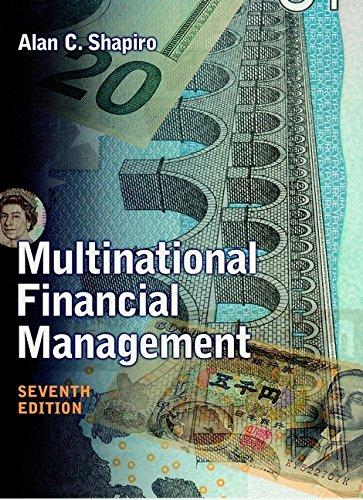Question
Read Case 42: Methods of Valuation for Mergers and Acquisitions. This case DOES NOT require a written case analysis. It does, however, require exacting attention
Read Case 42: Methods of Valuation for Mergers and Acquisitions. This case DOES NOT require a written case analysis. It does, however, require exacting attention to the formula and calculation techniques outlined therein.
Why is the DCF model better in M&A analysis (page 586)? Please pay special attention to Tables 1, 2, & 3.
What is Free Cash Flow (FCF) used in the model and how do we arrive at FCF?
(Use the 3 tables below to help answer the questions above)
TABLE 1 | Valuation of Company B as a stand-alone unit. (assume that Company A will allow Company B to run as a stand-alone unit with no synergies)
Revenue growth 6.0% Steady state growth 5.9%
COGS 55% WACC 10.9%
SG&A 20% Tax rate 39%
Year 0 year1 year2 year3 year4 year5 year6steady rate
Revenues ($thousands) 9,750 10,000 10,600 1,236 11,910 12,625 13,370
COGS 5,500 5,830 6,180 6,551 6,944
Gross profit 4,500 4,770 5,056 5,360 5,681
SG&A 2,000 2,120 2,247 2,382 2,525
Depreciation 1,000 1,000 1,000 1,000 1,000
EBIT 1,500 1,650 1,809 1,978 2,156
Less Taxes (585) (644) (706) (771) (841)
NOPAT 915 1,007 1,103 1,207 1,315 1,393
Add: depreciation 1,000 1,000 1,000 1,000 1,000
Less: capital expenditures (1,250) (1,250) (1,250) (1,250) (1,250) 664
Less: Increase in NWC (55) (132) (140) (148) (157) (164)
= Free cash flow 610 625 713 809 908 565
Terminal value 11,305
Free Cash Flows + Terminal value 610 625 713 809 12,213
Enterprise Value PV 10.9%(FCF)= 9,396
NWC (22% Sales) 2,145 2,200 2,332 2,472 2,620 2,777 2,941
NPPE(+CAPEX-Depr. Each year) 10,000 10,250 10,500 10,750 11,000 11,250 11,914
Operating margin[NOPAT/Sales] 9.2% 9.5% 9.8% 10.1% 10.4% 10.4%
PPE turnover[Sales/NPPE] 0.98 1.01 1.05 1.08 1.12 1.12
RONA[NOPAT/(NWC+NPPE)] 7.3% 7.8% 8.3% 8.9% 9.4% 9.4%
Year 6 Steady-State Calculations:
Sales= Year 5 Sales x (1+ Steady-State Growth) = 12,625 x 1.059 = 13,370
NOPAT = Year 5 NOPAT x (1+ Steady-State Growth) = 1,315 x 1.059 = 1,393
NWC = Year 5 NWC x (1 + Steady-State Growth) = 2,777 x 1.059 = 2,941
NPPE = Year 5 NPPE x (1+ Steady-State Growth) = 11,250 x 1.059 = 11,914
Increase in NPPE = Capital Expenditures less Depreciation = 11,250 - 11,914 = -664 Year 5 Terminal Value = Steady-State FCF / (WACC - Steady-State Growth) = 565 (0.109 - 0.059) = 11,305
(We dont use Company As WACC because it does not reflect the risk associated with the merger cash flows. In this case, one is better advised to focus on where the money is going rater that where the money comes from in determining the risk associated with the transaction)
Table 2 Inputs to WACC
Bidder Target
A-Co. B-Co.
Bond rating A BBB
Yield to maturity of bonds 7.2% 7.42%
Tax rate 39.0% 39.0%
After-tax cost of debt 4.39% 4.53%
Beta 1.05 1.20
Cost of Equity 12.18% 13.08%
Debt as % of capital 20.0% 25.0%
Equity as % of capital 80.0% 75.0%
10-year Treasury bond yield 5.88% 5.88%
Market risk premium 6.0% 6.0%
WACC 10.6% 10.9%
TABLE 3 | Valuation of Company B with synergies. (assume that Company B merges with Company A and realizes operational synergies)
Revenue growth 8.0% Steady-state growth 5.9%
COGS 53% WACC 10.9%
SG&A 19% Tax rate 39%
Net working capital(NWC) 22%
Year0 year1 year2 year3 year4 year5 year 6 steady state
Revenues ($thousands) 9,750 10,000 10,800 11,664 12,597 13,605 14,408
COGS 5,300 5,724 6,182 6,676 7,211
Gross profit 4,700 5,076 5,484 5,921 6,394
SG&A 1,900 2,052 2,216 2,393 2,585
Depreciation 1,000 1,000 1,000 1,000 1,000
EBIT 1,800 2,024 2,266 2,527 2,809
Less Taxes (702) (789) (884) (986) (1,096)
NOPAT 1,098 1,235 1,382 1,542 1,714 1,815
Add: Depreciation 1,000 1,000 1,000 1,000 1,000
Less: Capital expenditures (1,250) (1,250) (1,250) (1,250) (1,250) (664)
Less: Increase in NWC (55) (176) (190) (250) (222) (177)
=Free cash flow 793 809 942 1,086 1,242 974
Terminal value 19,490
Free cash flows + terminal value: 793 809 942 1,086 20,732
Enterprise Value PV 10.9%(FCF)= 15,140
NWC (22% sales) 2,145 2,200 2,376 2,566 2,771 2,993 3,170
NPPE (+CAPEX-depr. / year) 10,000 10,250 10,500 10,750 11,00011,250 11,914
Operating margin[NOPAT/sales] 11.0% 11.4% 11.9% 12.2% 12.6% 12.6%
PPE turnover[sales/NPPE] 0.98 1.03 1.09 1.15 1.21 1.21
RONA[NOPAT/(NWC+NPPE)] 8.8% 9.6% 10.4% 11.2% 12.0% 12.0%
Year 6 Steady-State Calculations:
Sales = Year 5 Sales x (1 + Steady-State Growth) = 13,605 x 1.059 = 14,408
NOPAT = Year 5 NOPAT x (1 + Steady-State Growth) = 1,714 x 1.059 = 1,815
NWC = Year 5 NWC x (1 + Steady-State Growth) = 2,993 x 1.059 = 3,170
NPPE = Year 5 NPPE x (1 + Steady-State Growth) = 11,250 x 1.059 = 11,914
Increase in NPPE = Capital Expenditures less Depreciation = 11,250 - 11,914 = -664 Year 5 Terminal Value = Steady-State FCF / (WACC - Steady-State Growth) = 974 (0.109 - 0.059) = 19,490
Step by Step Solution
There are 3 Steps involved in it
Step: 1

Get Instant Access to Expert-Tailored Solutions
See step-by-step solutions with expert insights and AI powered tools for academic success
Step: 2

Step: 3

Ace Your Homework with AI
Get the answers you need in no time with our AI-driven, step-by-step assistance
Get Started


